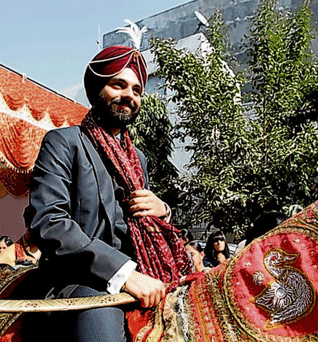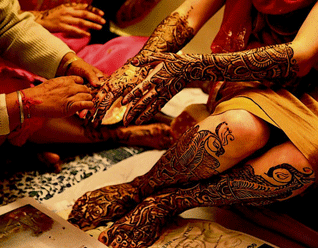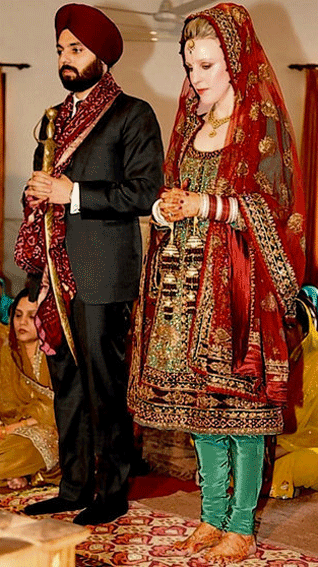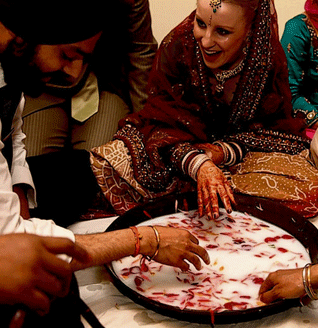Fashion
In The Sikh Tradition
by DEIRDRE McQUILLAN
"It was really magical," sighs fashion designer Joanne Hynes, recalling her wedding to her Sikh beau Kamal Singh Chana in New Delhi, India, earlier this year.
In particular, she remembers the special moment when the couple walked together to the gurdwara for the formal ceremony.
"You stop at every house and drums are beating and men are singing of love."
A European bride is a rare sight in the city, says Hynes, and everybody assumed she was American. "We didn't really want a big production, but for his family, a traditional Sikh wedding, which is a week-long affair, was really important."
More than 300 guests, the majority of them the groom's relatives and friends, along with Hynes's parents and a couple of family members from Galway, Irelad, attended the celebrations.
Joanne and Kamal met in New Delhi a few years ago. Kamal comes from a manufacturing family, trained in New Delhi, and has done a degree in fashion design and an MBA in luxury marketing at the Michael Smurfit Graduate Business School. Despite their different backgrounds, the couple share a lot in common.
"We can have a conversation about lining for half an hour, me starting from the creative end and he starting from the commercial side and we meet in the middle. He is technically very astute and has a real European sensibility, more tuned in than I am," she says. "At the moment he is doing a lot of work looking at artisan manufacturing."
The wedding, in the time-honoured Sikh tradition, full of ritual and ceremony, was a colourful, joyous event with much music, singing and dancing. "It was all new for his family, too, because traditionally the bride leaves from her own house and the groom from his, but I was staying with his family, so that was another novelty factor. People move into the house for the whole week, all the furniture is taken out and food is offered 24/7. [One of the ceremonies is] called 'jaggo', which means 'wake up'," she explains.
Her elaborate wedding attire consisted of a very ornate sari and four different suits of salwar kameez, gifts from the groom's family for the festivities. "What you wear is very important and the bride is the centre of attention, so there was a lot of pressure in that sense, particularly since I am not Indian. But the Sikh marriage is considered very sacred and I learnt a lot from it as one who has never felt connected to my own religion, which didn't have any relevance. Sikh belief is very scientific."
Her maroon and green velvet sari was covered in crystal and gold zari embroidery and she wore a veil and jewellery on her head. "I really enjoyed the process of choosing a sari. It is so pleasurable, you just wrap it around the body and there are no fitting problems, apart from the bodice. I loved the process of standing with my arms out and being draped by other people - I was off duty."
Traditionally every female guest at the wedding is given a suit, every man a gift.
Henna painting was another key stage of the ceremony. "It's done on the second day and traditionally the entire leg is painted. It took two guys three hours to paint my legs and hands and they inscribe the initials of the groom somewhere in the patterns and the groom has to find them. As the henna sets and dries, there is singing and dancing and food. Before the marriage ceremony, the henna is washed off with milk and rose petals and you have to wear special bangles for 40 days and 40 nights. So you are really in character and it's a ceremonial dress."
She has become fascinated by the sari "and from a trend point of view the radar is on Asia at the moment," she says. "I love the idea of draping and find it very therapeutic. If I feel low I go and drape on the dummy and it works. I just love the simplicity of it and you can see it coming through in a lot of collections such as those of Lanvin and Dries Van Noten."
Markets in places such as Dubai have now opened for Hynes and she adapts her collection accordingly. "Those collections have to be looser, freer, lighter, with strong colours - they're less complicated."
Although she didn't design her own bridal attire, she has designed for a number of wedding customers. "The new trend is for lifestyle weddings - customers will come in and say ‘I am going to XYZ and I want something that will work abroad'. We have a lot of brides buying dresses before the wedding. We had two brides recently for my white leather dresses."
Many women, however, want what she calls "the princess experience", particularly younger women. "But Irish women experiment a lot more, they don't come in with preconceptions and are open to ideas. Normally what they want to know is what will others think, what will the mother-in-law think?"
[Courtesy: The Irish Times]
August 13, 2010
Conversation about this article
1: Irvinder Singh Babra (Brampton, Ontario, Canada), August 14, 2010, 9:18 AM.
My congratulations to both.
2: Satwinder Singh (Dublin, Ireland), August 16, 2010, 10:18 AM.
Congratulations to Kamal & Joanne! I met them a few months ago in the Dublin Gurdwara, and was fascinated by their story. Had I met them a year ago, they could have been a very interesting subject for the Photo Exihibition, 'A Sikh Face in Ireland', which is currently on display here in the Chester Beatty Library at the moment.






